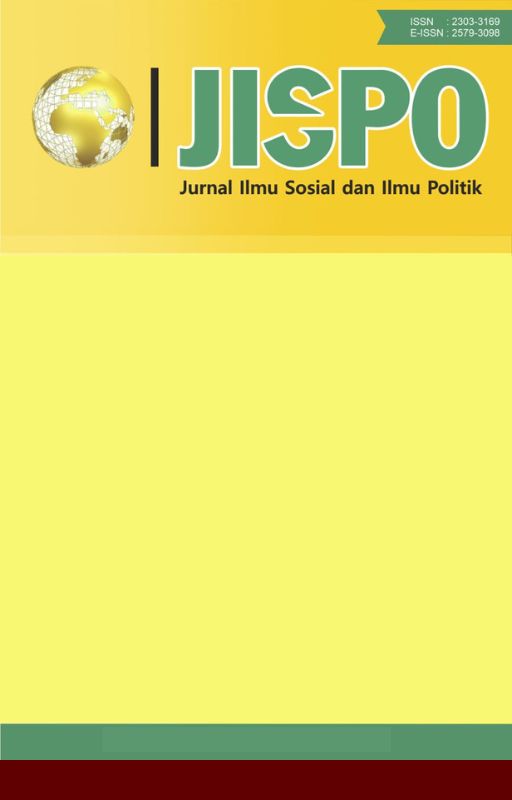PENGARUH PERILAKU REGRESI PADA INTERAKSI SOSIAL LANJUT USIA DI PANTI PELAYANAN SOSIAL LANJUT USIA BOJONGBATA PEMALANG
DOI:
https://doi.org/10.15575/jispo.v9i1.4145Keywords:
Regression Behavior, Social Interaction, Elderly Homes.Abstract
References
Adam, M.D & Milton, S. (1972). Regression in Old Age. Journal of National Medic Association Vol 64 (2).
Dulkiah, M., Sari, A. L., & Irwandi, I. (2018). The Impact of Conditional Cash Transfer (CCT) to Socio-Economic of Poor Families; A Case Study. Jurnal Ilmu Sosial Mamangan, 7(1), 32-39.
Bungin, B. (2006). Sosiologi Komunikasi Teori, Paradigma, dan Diskursus Teknologi Komunikasi di Masyarakat. Jakarta: Kencana.
Gerungan, W. A. (2009). Psikologi Sosial. Bandung: PT. Refika Aditama
Hentschel, U. et al. (2004). Defense Mechanism: Theoretical, Research and Clinical Perspectives. North Holland: Elsevier BV.
Hurlock, E. B. (2011). Psikologi Perkembangan: Suatu Pendekatan Sepanjang Rentang Kehidupan. Jakarta: Erlangga.
Kartinah & Sudaryanto, A. (2007). Masalah Psikososial pada Lanjut Usia. Berita Ilmu Keperawatan, Vol. I (94)., Hal. 93-96.
Kusumowardani, A. & Puspitosari, A. (2014). Hubungan Antara Tingkat Depresi Lanjut usia dengan Interaksi Sosial Lanjut usia di Desa Sobokerto Kecamatan Ngamplak Boyolali. Jurnal Terpadu Ilmu Kesehatan, Vol. 3 (2), Hal. 106-214.
Lestari, I., dkk. (2014). Pengaruh Gadget pada Interaksi Sosial dalam Keluarga. Prosiding KS: Riset & PKM. Vol 2 (2), Hal 147–300.
Martina, A., dkk. (2016). Interaksi Sosial Lansia di Badan Perlindungan Sosial Tresna Wredha (BPSTW) Ciparay dengan Keluarga. Prosiding KS: Riset &PKM Vol 3 (1), Hal. 38-42.
Okko, J. (2008). Understanding and Using Theory in Social Work. Wiltshire: Cromwell Press.
Papalia, D. E., et. al. (2009). Human Development (Perkembangan Manusia). Jakarta: Salemba Humanika.
Sanjaya, A. & Rusdi, I . (2012). Hubungan Interaksi Sosial dengan Kesepian pada Lanjut Usia. Jurnal Keperawatan Holistik, Vol 1 (3), Hal. 26-31.
Santrock, J. W. (2002). Life Span Development: Perkembangan Masa Hidup. Jakarta: Erlangga.
Sari, A. L. (2017). The Role Of Social Workers In The Development Of Tourism Villages. JISPO: Jurnal Ilmu Sosial dan Ilmu Politik, 7(2), 1-23.
Sinathria, D., dkk. (2012) Studi Fenomenologi: Pengalaman Interaksi Sosial Lanjut Usia dengan Sesama Lanjut usia dan Pengasuh di Panti Sosial Tresna Werdha “Sabai Nan Aluih†Sicincin Kabupaten Padang Pariaman Tahun 2012. NERS Jurnal Keperawatan Universitas Andalas. Volume 8 (1), Hal. 96-104.
Skidmore, R.A. (1994). Introduction in Social Work. University of Utah
Soekanto, S. (2007). Sosiologi Suatu Pengantar. Jakarta: PT. RajaGrafindo Persada.
Sunarto, K. (2004). Pengantar Sosiologi. Jakarta: Lembaga Penerbit Fakultas Ekonomi Universitas Padjadjaran.
Stolley, K.S. (2005). The Basics of Sociology. London: Greenwood Press.
Walsh, J. (2010). Theories for Direct Social Work Practice. California: Wadsworth Cengange Learning.
Widodo, H., dkk. (2016). Hubungan Interaksi Sosial dengan Kualitas Hidup Pada Lanjut usia di Wilayah Kerja Puskesmas Pekauman Banjarmasin. Dinamika Kesehatan: Jurnal Kebidanan dan Keperawatan, Vol 7 (1), Hal. 23-32.
Zastrow, C. & Kirst-Ashman, K. K. (2007). Understanding Human Behavior and the Social Environment. California: Thomson Brooks.
https://www.merdeka.com/sehat/kenapa-manula-berperilaku-seperti-anak-kecil.html
https://www.kompasiana.com/nindaratri/58a5c02fe222bd5a3ddce240/manula-seperti-anak-anak
https://gaya.tempo.co/read/577558/lapang-dada-dalam-merawat-orang-tua-manula
http://kidsgen.blogspot.com/2013/03/perubahan-kepribadian-di-usia-tua.html
http://www.chicagonow.com/geriatrics-city/2014/11/old-people-are-like-babies/
Downloads
Published
How to Cite
Issue
Section
Citation Check
License
Authors who publish their manuscripts in JISPO agree to the following terms:
- Authors retain copyright and grant the journal right of first publication with the work simultaneously licensed under a Creative Commons Attribution-ShareAlike 4.0 International License that allows others to share the work with an acknowledgment of the work's authorship and initial publication in this journal;
- Authors are able to enter into separate, additional contractual arrangements for the non-exclusive distribution of the journal's published version of the work (e.g., post it to an institutional repository or publish it in a book), with an acknowledgment of its initial publication in this journal; and
- Authors are permitted and encouraged to post their work online (e.g., in institutional repositories or on their websites) after publication process, or prior to and during the submission process, as it can lead to productive exchanges, as well as earlier and greater citation of published work (See The Effect of Open Access).




.jpg)



